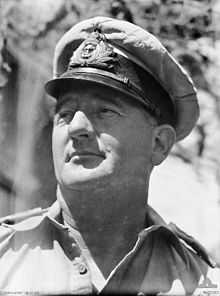Alfred Brian Palmer
| Alfred Brian Palmer | |
|---|---|
 Lieutenant Palmer in Tobruk, 11 Sept 1941 | |
| Nickname(s) | "Pedlar Palmer" |
| Born |
27 March 1899 Redfern, New South Wales, Australia |
| Died |
4 July 1993 Clearwater, Florida, United States |
| Allegiance |
|
| Service/branch | Royal Navy |
| Years of service |
1915 – 1918 1939 – 1945 |
| Rank | Commander |
| Battles/wars |
First World War Second World War |
| Awards |
Member of the Order of the British Empire Distinguished Service Cross |
Alfred Brian Palmer MBE, DSC (27 March 1899 Redfern, New South Wales – 4 July 1993 Clearwater, Florida) was a Royal Navy Reserve captain and near the end of his career was the commander of the shore base HMS Furneaux in Brisbane. He is known for his bravery in breaking the German blockade of Tobruk in the Second World War with his small schooner Maria Giovanni. During the Second World War he was wounded several times and finally taken prisoner by the Germans, from which he attempted numerous escapes. He was awarded the Distinguished Service Cross in 1941 for "courage, skill and devotion to duty in operations off the Libyan coast",[1] and made a Member of the Order of the British Empire in 1944.[2]
Early life
Palmer's name at birth was Alfred O'Brien. He first went to sea on the Daniel, a 185 ton sailing vessel built in Norway in 1830. After three voyages to New Zealand on the Daniel in November 1916 Palmer joined the Burrowa an Australian merchant sailing vessel (2902 gross tonnes). On 27 April Burrowa was attacked and sunk "sixty miles west of the Scilly Isles" by a German submarine.[3] The crew spent two nights in a lifeboat. They were sighted by a patrol plane, picked up and taken to Penzance. Palmer then served in the British navy until the end of the First World War.
Between the First and Second World Wars, Palmer was a merchant seaman[4] serving on many Commonwealth Line ships. He was a crew member of the Carawa when it was run aground in the Galápagos Islands.[5] The crew members returned to Sydney on the steamers Australrange and Australmont in July 1920.[6] In 1928, as the depression began, the Commonwealth line was sold and crews were retrenched.[7]
He commanded a company of the Chinese Lancers in Shanghai and was a member of the volunteer reserve.[4] On the outbreak of the Second World War he rejoined the Royal Navy,[4] and first served as executive officer of HMS Medway (F25).[8]
Maria Giovanni
The Maria Giovanni was a 200 ton schooner captured from the Italians by the British destroyer HMS Dainty on 1 January 1941.[9] Palmer was made skipper of the Maria Giovani in January 1941.[8]
He "won fame through his cussedness on the Spud Run",[10] and by his willingness to carry any cargo.
There is slight differences in how his ship was captured with one saying the Italians "trapped him by a ruse",[4] and the other saying the Germans "kidded him" to make landfall in their territory,[10] regardless Palmer and his crew became prisoners of war in Italy.[4]
The supply of Tobruk by Palmer and others was known as the "Ferry Service".[11]
CNRRA Incident
Palmer was accused of embezzlement while working as Marine Superintendent of Waterways Transport for the Chinese National Relief and Rehabilitation Administration in 1947.[12] He was convicted and sentenced to one year hard labour but the conviction was overturned on appeal.[13]
Later life
Palmer and his wife flew from Florida to Australia to attend a Rats of Tobruk reunion in 1977, where around 600 veterans marched through Sydney streets.[14]
Autobiography
- Pedlar Palmer of Tobruk (1981) Canberra, Australia: Roebuck Society. ISBN 0-909434-21-2
- The Pirate of Tobruk: a sailor's life on the Seven Seas, with Mary E. Curtis (1994), Annapolis, Maryland: United States Naval Institute. ISBN 1-55750-667-1.
References
- ↑ "Supplement to The London Gazette" (PDF). The London Gazette (Her Majesty's Stationery Office). 29 July 1941. p. 4370. Retrieved 19 December 2008.
- ↑ The London Gazette: (Supplement) no. 36825. p. 5571. 5 December 1944. Retrieved 20 December 2008.
- ↑ McDonell, Ralph (1976). Build a Fleet Lose a Fleet. Melbourne, Australia: The Hawthorn Press. ISBN 0-7256-0165-5.
- ↑ 4.0 4.1 4.2 4.3 4.4 Wilmot, Chester (1944). Tobruk, 1941. Ringwood, Victoria, Australia: Penguin Books. p. 276. ISBN 0-14-017584-9.
- ↑ "THE WRECKED CARAWA.". The Examiner (Launceston, Tas.: National Library of Australia). 19 April 1920. p. 5 Edition: DAILY. Retrieved 5 April 2011.
- ↑ "WRECKED STEAMER.". The Sydney Morning Herald (National Library of Australia). 22 June 1920. p. 9. Retrieved 4 April 2011.
- ↑ Kingsford-Smith, G. (23 September 1944). "An Adventurer Returns". The Sydney Morning Herald. p. 7. Retrieved 20 May 2010.
- ↑ 8.0 8.1 Kiester, Edwin Jr. (2007). An incomplete history of World War II. Sydney, Australia: Murdoch Books Pty Limited. pp. 59–65. ISBN 978-1-74045-981-5.
- ↑ Wade, Frank (2005). A Midshipman's War: A Young Man in the Mediterranean Naval War 1941–1943. Trafford. pp. 84–86. ISBN 978-1-4120-7069-0.
- ↑ 10.0 10.1 Harrison, Frank (1996). Tobruk, The Birth of a Legend. London, UK: Cassell Military Paperbacks. p. 154. ISBN 0-304-36258-1.
- ↑ Cochrane, Peter (2005). Tobruk 1941. Sydney, Australia: ABC Books. p. 60. ISBN 0-7333-1407-4.
- ↑ "CNRRA Head in Hongkong Faces Trial". The North-China Daily News. 8 June 1947.
- ↑ "High Court Upholds Palmer Appeal". The North-China Daily News. 15 October 1947.
- ↑ Albury, Chuck (27 August 1977). "Palmers participate in Sydney reunion of World Rats of Tobruk". St. Petersburg Times. Retrieved 11 March 2010.
|